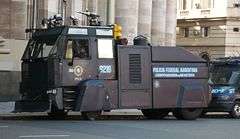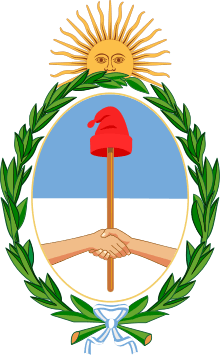Argentine Federal Police
| Argentine Federal Police Policía Federal Argentina | |
|---|---|
| Abbreviation | PFA |
|
Shield | |
|
Headquarters | |
| Motto |
Al servicio de la comunidad To serve the community |
| Agency overview | |
| Formed | December 24, 1943 |
| Preceding agencies |
|
| Legal personality | Governmental: Government agency |
| Jurisdictional structure | |
| Federal agency (Operations jurisdiction) | Argentina |
| Legal jurisdiction | As per operations jurisdiction. |
| General nature |
|
| Operational structure | |
| Headquarters | Departamento Central de Policía, 1650 Moreno Street, Buenos Aires |
| Sworn members | 25,000 |
| Agency executives |
|
| Website | |
|
www | |
| Footnotes | |
|
The Policía Federal Argentina, while a federal agency, also provides direct policing to the capital city Buenos Aires Phone: 54 11 4378-5800/4346-7000/4809-6100 | |

The Argentine Federal Police (Spanish: Policía Federal Argentina or PFA) is a civil police force of the Argentine federal government. The PFA has detachments throughout the country, but its main responsibility is policing the Federal District of Buenos Aires. Argentine Federal Police duties in Buenos Aires have been gradually taken over by a new force, the Policía Metropolitana de Buenos Aires (Buenos Aires Metropolitan Police).[1]
History
The history of this police force can be traced to 1580, when the founder of Buenos Aires, Captain Juan de Garay, established a local militia for defense against potential Native American raids. The Policía de Buenos Aires (Buenos Aires Police) operated for the first three hundred years up to 1880, when the Federalization of Buenos Aires resulted in the creation of the Policía de la Capital (Police of the Capital).
Incidents of social unrest in subsequent years helped prompt the Fraga Law in 1904, which provided for the inclusion of neighborhood representatives as commissioners in their respective precincts. The failed Revolution of 1905, by which the UCR sought to bring about reforms to the undemocratic electoral system, led to the appointment of a conservative congressman, retired Col. Ramón Falcón, to the post of chief of police; Falcón's repressive tenure ended with his 1909 assassination.[2]
The current entity resulted from an initiative by the chief of police, Col. Emilio Ramírez, assisted by LTCOL Enrique Fentanes. A panel convened by the police chief presented its findings to support the establishment of the Federal Police on November 8, 1943, and on December 24, Decree 17.750 was signed by President Pedro Pablo Ramírez (the father of the chief of police). The new force did not immediately replace the Capital Police, but was instead transferred duties under the latter's purview incrementally. The first important such transfer was the February 7, 1944, assignment as the Presidential Guard of the Casa Rosada, and on March 10, the process of unifying the two forces was initiated by decree, concluding officially on January 1, 1945.
The Federal Police changed slowly in its organizational structure in subsequent decades. Initially maintaining 45 precincts, it added five in 1946, two in 1976, and a 53rd in 1999. Its subordinate role to the national executive increasingly made the force a political instrument during the country's often authoritarian regimes. General Juan Carlos Onganía, president after a 1966 coup, named a Federal Police director, Luis Margaride, who shared his distaste for modern culture, resulting in crusades against nightclubs, long hair, and miniskirts.[3] Facing a government policy backdrop such as this, numerous avant-garde artists (and others, particularly in academia) left Argentina, many never to return.[3] The return of exiled President Juan Perón in 1973 resulted in conflict with the PFA, when the calculating populist had Alberto Villar named as chief at the behest of adviser José López Rega. Villar was a member of López Rega's newly organized paramilitary group, the Argentine Anticommunist Alliance, and Villar's participation in spiraling violence between the group and those on the far left led to his assassination in 1974. The institution's prestige was further damaged following the March 1976 coup, when the force participated in the abduction, torture and murder of thousands of dissidents and others.[3] It was only with the 1983 presidential elections (and the return to democratic rule) that the FP began restoring its prestige and its relations with the Argentine people, especially with the 1986 appointment of Juan Angel Pirker as police commissioner general.
The 1993 Olivos Pact between President Carlos Menem and his predecessor, UCR leader Raúl Alfonsín resulted in the 1994 reform of the Argentine Constitution, whose article 129 granted the City of Buenos Aires greater self-governance. This in principle included the transfer of control of the 25,000-strong Federal Police to the Jefe de Gobierno (elected Mayor), and the Buenos Aires City Legislature. Shortly before the historic, June 30, 1996, elections to these posts, however, a senior Peronist Senator, Antonio Cafiero, succeeded in limiting the city's autonomy by advancing National Law 24.588, which reserved control of the force, among other faculties, to the national government.[4]
The controversial bill, signed in 1996 by President Menem, remained a sticking point between successive Presidents (most of whom have been Peronist) and Buenos Aires Mayors (none of whom have been). A 2005 agreement on principles between Mayor Aníbal Ibarra and President Néstor Kirchner was followed by the modification of the especially contentious article 7, which denied the city its own, local police force, in 2007 - though the "Cafiero Law" otherwise remains in force. Efforts since 2007 by Mayor Mauricio Macri to declare it unconstitutional have thus far failed, and though the Mayor inaugurated a Metropolitan Police, issues of revenue sharing for its financing remain pending.[5]
The PFA, since 1974, maintains a university specializing in criminology, is associated with Interpol, and participates in special forces training programs at the Los Angeles Police Department.
General Organization

The PFA is subordinate to the Ministry of Interior. The organization is headed by the Chief of the PFA, the Comisario General Román Argentino Di Santo, assisted by the Deputy Chief of the PFA, Comisario General Héctor Eduardo Tebes.
The PFA's headquarters, known as the Departamento Central de Policía, is located at 1650 Moreno Street, in the Montserrat section of Buenos Aires. The over 12,000 m² (128,000 ft²) resulted from an 1868 proposal for its construction, which was ultimately approved in 1884. Designed by Juan Antonio Buschiazzo, and engineered by Francesco Tamburini, the ornate headquarters is an eclectic structure with influences from Baroque architecture, and features a number of patios, notably the central, Palm Tree Patio. Argentine Passports were issued to local residents at this location until 1996.
The organization of the PFA is as follows:
- Jefatura (Headquarters)
- Subjefatura (Subheadquarters)
- Superintendencias (Superintendencies)
- Superintendencia de Administración (Superintendency of Administration)
- Superintendencia de Bienestar (Superintendency of Welfare)
- Superintendencia Federal de Bomberos (Federal Firefighting Superintendency)
- Superintendencia de Investigaciones Federales (Superintendency of Federal Investigations)
- Superintendencia de Planificación y Desarrollo (Superintendency of Planning and Development)
- Superintendencia de Seguridad Metropolitana (Superintendency of Metropolitan Security)
- Superintendencia de Personal, Instrucción y Derechos Humanos (Superintendency of Personnel, Instruction and Human Rights)
- Superintendencia de Policía Científica (Superintendency of Scientific Police)
- Superintendencia Federal de Tecnologías de la Información y Comunicaciones (Federal Superintendency of Information Technologies and Communications)
- Superintendencia de Interior y Delitos Federales Complejos (Superintendency of Interior and Federal Complex Crimes)
- Superintendencia de Drogas Peligrosas (Superintendency of Dangerous Drugs)
- Superintendencia de Asuntos Internos (Superintendency of Internal Affairs)
- Superintendencia Federal de Transporte (Federal Superintendency of Transport)
- Direcciones Generales Autónomas (General Autonomic Directorates)
- Dirección General Autónoma de Asuntos Jurídicos (General Autonomic Directorate of Legal Affairs)
- Dirección General Autónoma de Asuntos Internos (General Autonomic Directorate of Internal Affairs)
Superintendencies are commanded by a superintendente, a less common word in Spanish. Both superintendente and the much more common Spanish word comisario normally translate into English as superintendent, which creates some translation problems when discussing Argentine police services.
Training for all serving agents of the service is done by the following institutions:
- Federal Police Agents and Suboficials School "Don Enrique O'Gorman"
- Federal Police Academy "Commissioner General Juan Angel Pirker"
- Federal Police Staff College "Commissioner General Enrique Fentanes"
Aside from stations in Buenos Aires, it maintains provincial stations in select capital cities and several towns of the Provinces of Argentina. The FFS also doubles as the state fire service as well.
Police Ranks
Officer Ranks (in descending order)
| Rank | Approximate English translation | Badge of rank |
|---|---|---|
| Comisario General - Jefe de Policia | Superintendent-General / Commissioner-General - Chief of Police | Four gold pips above a gold band & wreath |
| Comisario General | Superintendent-General or Commissioner-General | Three gold pips above a gold band & wreath |
| Comisario Mayor | Superintendent-Major or Commissioner-Major | Two gold pips above a gold band & wreath |
| Comisario Inspector | Superintendent-Inspector or Commissioner-Inspector | One gold pip above a gold band & wreath |
| Comisario | Superintendent or Commissioner | Two gold pips above a gold band |
| Subcomisario | Sub-commissioner | One gold pip above a gold band |
| Official Principal | Principal Officer | Three silver pips |
| Official Inspector | Inspector Officer (or just Inspector) | Two silver pips |
| Official Subinspector | Sub-inspector Officer (or just Sub-Inspector) | One silver pip above one gold pip |
| Official Ayudante | Adjutant Officer or Assistant Officer | One silver pip |
Sub-Officer Ranks (in descending order)
| Rank | Approximate English translation | Badge of rank |
|---|---|---|
| Suboficial Mayor | Subofficer-Major | Four chevrons above an Austrian knot |
| Suboficial Auxiliar | Auxiliary Sub-Officer | Three chevrons above three arcs |
| Suboficial Escribiente | Clerk Sub-Officer or Administrative Sub-Officer or Staff Sub-Officer | Three chevrons above two arcs |
| Sargento Primero | First Sergeant or Sergeant First Class | Three chevrons above an arc |
| Sargento | Sergeant | Three chevrons |
| Cabo Primero | First Corporal | Two chevrons |
| Cabo | Corporal | One chevron |
| Agente / Bombero | Officer / Fireman | |
| Aspirante | Candidate or Cadet |
See also
- Albatross Group
- Scorpion Group
- Hawk Special Operations Brigade
- Federal Special Operations Group
- Interior Security System
- Law Enforcement in Argentina
References
- ↑ Indymedia.org, Tuesday, Mar. 18, 2008 at 1:44 PM. Macri Presents the Metropolitan Police.
- ↑ Pigna, Felipe. Los mitos de la historia argentina 2: De San Martín a 'El granero del mundo'. Buenos Aires: Planeta, 2005.
- 1 2 3 Andersen, Martin. Dossier Secreto. Westview Press, 1993.
- ↑ Infobae: Qué dice la Ley Cafiero (Spanish)
- ↑ Parlamentario: Piden que declaren inconstitucional la ley Cafiero (Spanish)
External links
- Official website (Spanish)
Coordinates: 34°36′47″S 58°23′17″W / 34.61306°S 58.38806°W

